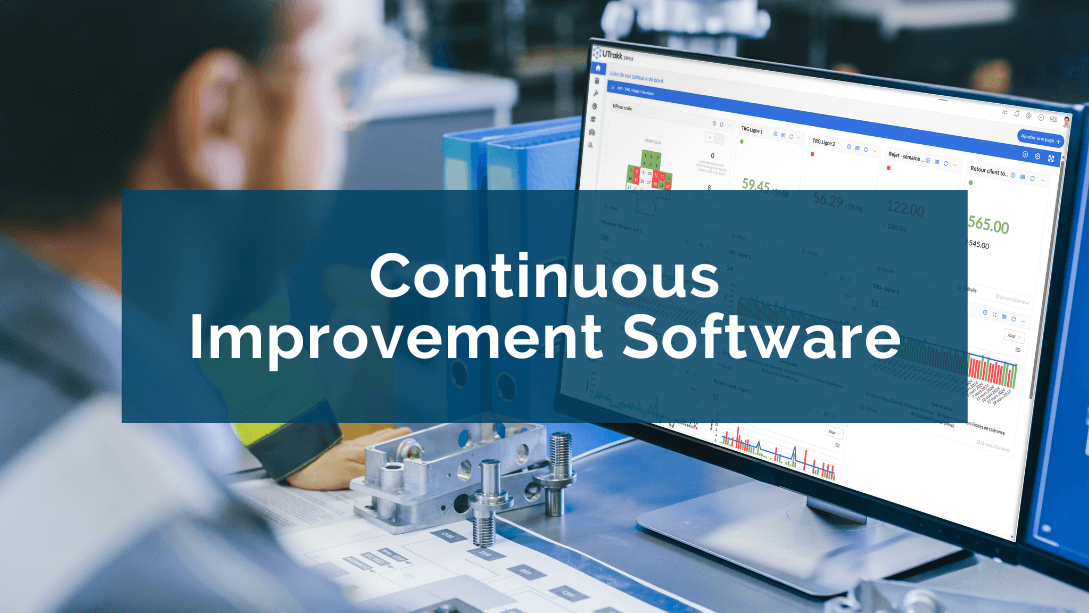What is a continuous improvement software?
A continuous improvement software helps organizations continuously improve business processes and product and service quality, and improve efficiency. Particularly useful on the factory floor, it can also be used by companies of all sizes and industries, by specialists, managers, and employees involved in continuous improvement.
A continuous improvement software:
- Facilitates data collection and analysis, enabling immediate variance identification and problem-solving.
- Supports work standardization and process optimization.
- Tracks performance through key indicators.
- Helps manage improvement projects efficiently.
In short, it's a strategic pillar for boosting competitiveness, enhancing employee engagement, and promoting a culture of continuous improvement within the organization.
Why is it essential to use a continuous improvement software?
Using a continuous improvement software offers several possibilities and benefits to organizations.

Greater efficiency and productivity
Continuous improvement software helps quickly identify and resolve inefficiencies by facilitating the collection and analysis of operational data, reduce errors and bottlenecks by standardizing work processes, and foster optimal resource allocation and productivity improvement by streamlining project management.
Enhanced visibility and transparency
Recurring processes (production, maintenance, delivery, etc.) and procedures are centralized, enabling all employee levels to access relevant information, while comprehensive dashboards and detailed reports offer real-time visibility of key performance indicators (KPIs), progress made, and areas requiring attention, reinforcing transparency and alignment within teams.
Process standardization
A continuous improvement software standardizes production processes by documenting, implementing, and monitoring operational procedures – all in one platform. It ensures that both machines and methods are consistent and compliant throughout the organization, reducing variability and non-compliance.
Faster problem resolution
Continuous improvement solution helps identify variances in comparison to predefined standards, KPIs or expectations, perform root cause analysis, and implement corrective and preventive actions, to avoid problem escalation and minimize the negative impact on operations.
Increased employee engagement and accountability
Such software contributes to setting up regular communication channels that encourage information and knowledge sharing, ideas and feedback, involve employees in process improvement and problem-solving, and clarify roles and responsibilities in both daily tasks and organization's overall success, increasing accountability and employee engagement.
Cost reduction
Continuous improvement tools optimize processes and eliminate waste, identifying bottlenecks, repetitive tasks, and non-essential activities for more efficient resource allocation and reduction in costs associated with correcting defects.
Better adaptability to change
By providing real-time data, structuring work processes, and facilitating communication and team collaboration, these tools help rapidly identify and integrate changes, making organizations more resilient to disruption, better prepared to seize opportunities, and more competitive in the long term.
Data-driven decision-making
With continuous improvement software enabling KPI monitoring and analysis in real-time, strategic decisions are based on accurate, up-to-date results.
Increased customer satisfaction
Being able to quickly identify and resolve problems through a continuous improvement software optimizes the quality of products and services, and reduces errors and delivery times, for a maximum impact on customer satisfaction.
How UTrakk features support continuous improvement
The UTrakk Daily Management System (DMS) offers a structured approach based on the PDCA method that ensures improvement activities are planned, completed on schedule, measured, and adjusted as necessary, in alignment with organizational objectives – all in a repeated cycle.
Here's how UTrakk's user-friendly features put these initiatives into action, contributing to organizations' success in embracing continuous improvement.
Identify improvement opportunities
The “Plan” step (the "P" in the PDCA cycle) involves regular monitoring of daily operations to spot inefficiencies, recurring problems, or variances that indicate where improvements can be made.
In UTrakk DMS, these observations on the factory floor can be carried out through ritualized, digitalized active supervision tours and audits that include checklists enabling managers to ask their teams the right questions and assess relevant control points. This helps them identify problems and record potential improvement actions to take.
Record and track opportunities
Once actions have been recorded and documented, they need to be evaluated: if they require a more complex plan, they are converted into opportunities. UTrakk's Opportunities function enables opportunities to be created and documented in a structured and detailed way – description, priority level, persons responsible, due date, associated costs, workload, and more – which helps track progress of improvement efforts efficiently.
Other UTrakk features essential to the “Plan” step
- Dashboards, checklists, and audit tools: Collect and analyze data to reveal variances.
- KPIs: Set performance targets or standards to be achieved.
- Actions: Document each action and develop a plan.
Implement improvement actions
Action plans associated with recorded opportunities can be defined to execute continuous improvement initiatives – this is the "D" (“Do”) in the PDCA cycle.
In the UTrakk solution, these actions include detailed information, just like an opportunity. Other functions such as linking to a recurring meeting and activating validation steps, ensure that improvement actions are regularly monitored and completed according to expectations.
Other UTrakk features essential to the “Do” step
- Rituals (regular meetings): Implement action plans and ensure that all stakeholders are informed and involved.
Hold regular follow-up meetings
At the “Control” step (the "C" of the PDCA cycle), regular follow-up meetings can be scheduled using UTrakk's Rituals module, to assess the progress of actions associated with improvement opportunities.
These meetings provide a platform for reviewing the progress of activities, potential obstacles, and results achieved, as well as defining next steps. They also create an effective communication loop with managers who raised variances and documented actions at the planning step.
Measure progress with KPIs
UTrakk's operational dashboards measure the progress of continuous improvement initiatives by presenting associated KPIs in a user-friendly interface.
For example, if a manufacturing organization needs to optimize the uptime of its machines, Overall Equipment Effectiveness (OEE) indicators such as the machine availability rate or the product quality rate, can be monitored, analyzed, and compared with the set targets to assess the effectiveness of the improvement actions and see if adjustments are necessary to boost performance.
Manage and steer improvement projects
If improvement activities produce the desired results, the new business processes can be standardized and integrated into regular operations. However, if modifications are required, action plans need to be adjusted until the desired results are achieved – this is the "A" (“Act”) in the PDCA cycle.
At this step, the Project Tracking module in UTrakk DMS is essential to effectively manage and steer more complex improvement projects, from start to finish. This feature lets you structure the steps and sub-steps of the project, and define associated tasks to which responsibilities and due dates are assigned. It only takes 2 clicks from the intuitive user interface to convert improvement opportunities into projects, and associated actions into tasks.
Improvement projects can be linked to meetings, so that progress can be regularly monitored and results evaluated, perpetuating the continuous improvement cycle.
Other UTrakk features essential to the “Act” step
- Knowledge Center: Document and digitalize best practices and lessons learned for future reference.
By following and repeating the steps of the PDCA method, the UTrakk Daily Management System creates a cycle of continuous improvements, where opportunities are constantly identified, implemented, evaluated, and adjusted to ensure more improvements are made over time, leading to optimal performance and operational excellence.
Continuous improvement journey: 8 Tips to get the most out of your software

1. Digitalize continuous improvement methods
Integrate continuous improvement models into your software. For example, you can:
- Create interactive checklists for 5S audits.
- Record observations during Gemba Walks.
- Document and track the PDCA cycle.
- Manage improvement projects.
- Analyze data more accurately with DMAIC (as part of the Six Sigma methodology) analytical tools.
Digitalization makes continuous improvement processes more accessible, monitoring more consistent and immediately adjustable, leading to faster, more sustainable progress.
2. Encourage managers to take ownership of improvement in their departments
When leaders set the example by taking ownership of continuous improvement software, actively integrating it into their daily practices, and valuing its results, they set a positive example for all staff.
This involvement signals the importance of the continuous improvement approach and encourages all company levels to become actively involved.
3. Ensure adoption by managers and supervisors
As with executives, the commitment of managers and supervisors is a key success factor for improvement initiatives. Encourage them to actively use the software, to prove its importance by using it themselves, and to provide regular feedback.
This approach not only reinforces the effective use of the software but also creates a culture of continuous improvement where managers are key players in promoting and achieving positive change.
4. Link software to objectives
There are lots of continuous improvement software options. Make sure that its use is in line with the organization's strategic goals and long-term vision. This synchronization helps focus improvement initiatives on high-impact areas and strengthens stakeholder engagement by showing how each action contributes directly to strategic success.
Such alignment ensures that software is a driving force in achieving long-term objectives rather than simply an isolated operational system.
5. Centralize improvement projects and action plans
Centralizing your improvement projects and action plans in your continuous improvement software gives you a unified, consistent view of all ongoing initiatives.
This centralization facilitates coordination, communication, and progress monitoring, ensuring that efforts align with corporate objectives. It also makes it easier to analyze performance and results, enabling informed decision-making and efficient resource allocation.
6. Use issues raised during active supervision tours and audits to generate ideas for improvement
During active supervision tours and audits, record questions and observations, then use them to develop new solutions.
Incorporating these innovative ideas into your software creates a structured, ongoing process for turning business challenges into tangible, measurable, continuous improvements.
7. Train teams
Team training is crucial to maximizing the effectiveness of your continuous improvement software. A thorough understanding of the software, its functionality, and its practical application enables your teams to make optimum use of the tool in their day-to-day work.
Regular training ensures competent use of the software and encourages wider adoption and deeper integration of the continuous improvement culture within the organization.
8. Get feedback from users
Encouraging users of your continuous improvement software to provide feedback on their experience is crucial to refining and adapting the tool to their needs.
Their regular feedback provides valuable insights into the software's functionality, ergonomics, and efficiency. It also creates a sense of ownership and commitment among users, reinforcing their involvement in the company's overall improvement process.
Leverage powerful software to elevate continuous improvement
An organization's ability to adapt quickly and effectively to change often determines its success or failure. And that's just it: investing in continuous improvement software like UTrakk is not just a tactical decision; it's a gas pedal for transformation.
The adoption of this tool leads to a significant improvement in efficiency and productivity while strengthening the company's adaptability. Centralizing data, standardizing processes, enabling data-driven decision-making, and facilitating rapid problem resolution pushes organizations to greater operational performance.
However, it's essential to recognize that technology itself is only part of the solution. To realize the full potential of this software, it is necessary to instill and maintain a culture of continuous improvement. It means promoting a proactive attitude to change, encouraging the participation of all employees, and valuing constant innovation at all levels.
By combining the strategic use of continuous improvement software with a strong, dynamic corporate culture, modern businesses equip themselves with the assets they need to embrace the changing curves of their environment and sustain consistent growth.









